This piece is the first part of the JAWS online series of Reflections from Tōhoku
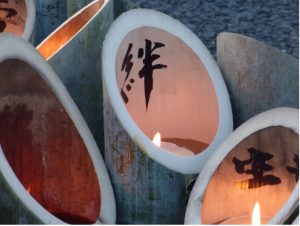 It was the earthquake, not my alarm clock, that woke me up on March 11th 2011. At that point I was about six months into my study abroad year in Tokyo as an undergrad. I had spent the night before singing karaoke until early morning with my friends, a then common practice among exchange students before the COVID pandemic.
It was the earthquake, not my alarm clock, that woke me up on March 11th 2011. At that point I was about six months into my study abroad year in Tokyo as an undergrad. I had spent the night before singing karaoke until early morning with my friends, a then common practice among exchange students before the COVID pandemic.
For this reason, my partner and I were still at home when the shaking started at 14:46 p.m. We had experienced strong earthquakes before, so we were not worried about the tremors at first. Then the trembling became remarkably stronger, toppled my TV, broke my washing machine, and continued for about 3 minutes straight. After the shaking ended and my friends and I called one another, to our relief finding each other ok. We naively thought that this trembling might have been “the big one”: the major earthquake expected to hit the Tokyo Metropolitan Region. Only after turning on the TV we realized the earthquake had hit further up north, and saw the events unfolding in Tohoku.
Even today, I am moved by how many of my Japanese friends took the time to care for me and other students, despite gravely worrying about relatives in Tohoku they could not reach. I will never forget how my neighbor handed me a handwritten note with the translations for teiden (blackouts), genpatsu jiko (nuclear accident), and notes on the reduced train schedule. I remember the woman in the supermarket who helped us find bread after the panic buying had started. And of course, I remember the images of people in Tohoku quietly standing in line to get fuel and food.
Although worldwide social support after disasters is more common than riots, looting, or other forms of social disturbances (Oliver-Smith 1999, Solnit 2009),and indeed there were cases of theft and other smaller crimes (Abe et al 2014), it may have been such images that inspired international media to spread wonder and stereotypical images about “the selfless, incredible people” (Stern 2011) and provoke questions such as, “Why is there no looting in Japan after the earthquake?” (BBC 2011). Soon after the triple disasters, social cohesion was also emphasized in Japan through the use of the term “kizuna,” or “bonds.” This term became the kanji of the year in 2011 and along with other expressions stressing cohesion, such as ganbarō (we can do it, let’s hang in there), it became a slogan for the 2011 disasters (Gerster-Damerow 2019, Gerster 2019, Richter 2015, Suter 2016, Tagsold 2012). Today, the kanji and romaji writing for kizuna can be found at souvenir shops in disaster-affected areas on key-chains, badges, sweaters, and bags. More than ten years after the disaster, many survivors state that the term helps them to express gratitude for all the support they have received over the years from Japan and abroad.
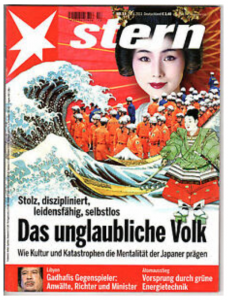
“The cover of the german magazine “Stern” in response to the 3.11 disasters. It reads: The incredible people. Proud, disciplined, enduring, selfless. How culture and disasters influence the mentality of the Japanese.”
However, despite providing comfort for some, not everybody is in favor of the emphasis on cohesion and selflessness in the post-disaster setting. Especially (but not only) in Fukushima Prefecture, I encountered more critical voices during my field research on the topic for my PhD. “There is another reading of 絆,kizuna, ” explained a woman from Minamisoma in 2017, “if you read the kanji as hodashi (bonds), it emphasizes the binding effect, like a foot bind. It binds you to something so that you cannot escape. You cannot be free”. Throughout more than five years of fieldwork, I repeatedly heard similar concerns, especially from women who emphasized that they felt they could not speak their minds freely or voice criticisms against the handling of the nuclear disaster, safety issues, or the recovery process in general. “If social cohesion is emphasized all the time,” a woman who evacuated with her family from Namie explained to me in 2020, “you cannot be the only one who thinks differently”. Slater et al. (2014) have observed similar concerns, stating that women in particular faced difficulties and pressure navigating their roles as caregivers and wives while simultaneously being responsible for their family’s health or supporting their husbands who in many cases preferred not to evacuate after the nuclear disaster.
Similarly, young adults who experienced the disaster as children expressed their distress towards the term. A woman from Soma in her twenties who experienced the disaster as a child told me in 2021, “Looking back, I hated the term kizuna. The mass media keep using that term, but if you access social media, you will encounter a completely different world. People would accuse residents of Fukushima Prefecture as being polluted or spreading radiation and spread rumors about us and our homes. What kind of kizuna is that? But it is difficult to complain because according to the promoted kizuna image, we have to be thankful, and everybody is supportive .”
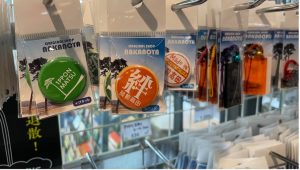
Kizuna and other recovery goods sold at the michi no eki in Rikuzentakata
These issues highlight the tendency to shift responsibility for supporting those affected by a crisis from the government to individuals through such emphasized discourses on social cohesion. For instance, directly after the 2011 disasters, residents were asked to support the Tohoku region by consuming products from the disaster-stricken areas through several “eat to support” programs (Kimura 2016, Reiher 2014; Sternsdorff-Cisterna 2019). On the one hand, this meant that many people felt the pressure to buy products from Fukushima Prefecture although they did not trust the official safety measures after products that exceeded radiation limits entered the market (Reiher 2014). On the other hand, in interviews farmers from Fukushima Prefecture often described their shock when they found the products that they had sold thrown into trash bins later. In both cases, consumers and producers felt that they had not received enough support by the government to take informed actions. Yet, through the emphasis on support and unity they were afraid being accused of spreading a negative image of the disaster-affected regions. Similarly, in his book “don’t say kizuna” (kizuna wo iu na!), Shibui (2016) criticizes how the term created an image of the ideal victim that was not supposed to complain despite apparent problems, especially in Fukushima Prefecture, such as the contaminated soil that no other Prefecture accepted to store, differences in compensation payments, or bullying. Referring to the psychologist Tamaki Saito, Tagsold (2012) further comments on the social pressure raised by terms such as kizuna and emphasizes that they served as a convenient cover-up tactic from the state to withdraw from responsibilities in favor of market economy solutions. According to him, the emphasis on kizuna reminded of the 1995 Hanshin-Awaji Earthquake, when much of the disaster response relied on volunteers (Tagsold 2012).
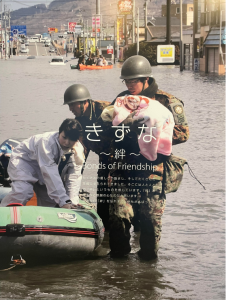
A panel highlighting “Kizuna – Bonds of Friendship” displayed at the Ishinomaki Tsunami Recovery and Community Center (Picture Credits: Ishinomaki Hibi Shinbun)
We can see striking similarities in the communication and handling of the COVID-19 pandemic as well. The COVID-19 pandemic not only coincided with the tenth anniversary of the Great East Japan Earthquake, but also with the ill-fated and once called “Recovery Olympics” (fukkō gorin). Over the now nearly two years of the ongoing pandemic and during these events, people faced conflicting messages. Citizens are asked to stay together, support each other, and “overcome the corona crisis through their local and strong bonds (kizuna)” (see for instance, Takaoka City 2021), or to hold on to the “kizuna that cannot lose against the novel corona virus”[shingata korona ni makenai kizuna messēji] (Ehime Prefectural Niihama Commercial High School 2021), while avoiding physical contact and keeping “social distance” to not get infected. Further, support programs such as “go to travel” or “go to eat” that encourage users to support struggling business owners while receiving discounts, are reminiscent of the “eat to support” programs which began in 2011. In Miyagi Prefecture, the 2020 version of the “eat to support” program was carried out by the “Miyagi kizuna consortium” under the name “meal ticket to support certified restaurants” (Miyagi Prefecture 2021). These COVID-19 “go to” programs, however, were criticized for contributing to the spread of infection (Asahi Digital 2020, NHK 2021) and may further be seen as yet another way of placing the burden of support disproportionately on residents.
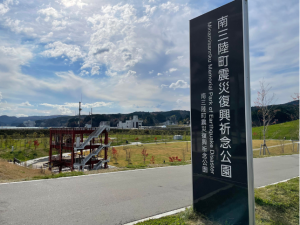
The Minamisanriku Memorial Park opened in October 2020 to commemorate the 3.11 disasters and serve as a learning facility. Yet, as of now, it remains mainly empty due to ongoing COVID-19 travel restrictions
In addition to the economic downturn that followed the disaster in Tohoku and only worsened during the pandemic, the call for social distancing during the covid crisis itself became a source of distress for many survivors of 3.11. Indeed, many survivors opposed the politicized tenth anniversary and the so called “Recovery Olympics,” as they feared they could falsely portray the recovery process as complete. Others however also hoped that these events would provide a chance to welcome visitors from all over Japan and the world, give back to those who supported them, and put a spotlight on the current situation of Tohoku where the signs of the disaster are still visible. These divergent sentiments among the survivors can help to show the oversimplified character of kizuna and social cohesiveness of communities, as well as the differing ways in which people are observing and experiencing their surroundings. While for some survivors the tenth anniversary was a chance to show how far they had come after losing everything, for others it was a chance to portray how the recovery process is still far from being finished, with communities still being dispersed and nuclear exclusion zones remain. In the end, however, the narrative of the “recovery games” shifted from drawing attention to the recovery process of the 2011 disasters to overcoming the COVID-19 pandemic. The torch rally through the disaster-affected areas took place mostly without spectators, and the disaster survivors hardly had any opportunity to share their thoughts and current situations with an international community.

The annual Tohoku Kizuna festival, usually celebrated to showcase summer festivals of the six Tohoku prefectures, was canceled in 2020 due to the COVID-19 pandemic
For me personally, The Great East Japan Earthquake and its aftermath has shaped not only my attitude towards Japan but also my personal life and career choices. Even after more than a decade of working on recovery-related topics, I am still amazed by the friendliness and support that I continue to receive from people who have lost more than I could imagine. Still, I think that is necessary to be cautious whenever social ties or cohesion are politicized, such as the branding of social cohesion as a “national character trade” or the projection of cohesion imagery to cover up failing support measures and silence unwanted voices. However, I am also grateful for the relationships that developed with the people I met within these ten years of recovery, and I hope that the survivors’ voices will continue to be heard by a wide audience also long after the tenth anniversary of 3.11.
Dr. Julia Gerster is an Assistant Professor at the Disaster Culture and Archive Studies Division of the International Research Institute of Disaster Science (IRIDeS) at Tohoku University. She received her PhD in Japanese studies with a disciplinary focus in social anthropology at Freie Universität Berlin in 2019. Her main research interests include the dynamics of social relations after disasters, community building, collective memory and the handling of negative heritage.
References
Abe Tsuneyuki, Wiwattanapantuwong Juthatip and Honda Akio (2014). Dark, cold and hungry, but full of mutual trust: manners among the 2011 Great East Japan Earthquake victims, Psychol. Russia: State of the Art 7 (1), pp. 4–13.
Asahi Digital (2020) GoTo issai teishi, yatō „amari ni osoi“ to hihan (Go to stopped, “too late” criticizes the opposition) 14.12.2020 https://www.asahi.com/articles/ASNDG6WFFNDGUTFK01V.html
BBC (2011) Why is there no looting in Japan after the earthquake?, 18.3. 2011. Available
at: https://www.bbc.com/news/magazine-12785802
Ehime Prefectural Niihama Commercial High School (2021) Shingata korona uirusu ni makenai kizuna! Messēji (Messages about the kizuna that won’t lose against the novel corona virus). https://niihama-ch.esnet.ed.jp/corona201202
Gerster-Damerow Julia (2019). The ambiguity of kizuna: The dynamics of social ties and the role of local culture in community building in post-3.11 Japan. Dissertation, Freie Universität Berlin.
Gerster Julia. (2019). Hierarchies of affectedness: Kizuna, perceptions of loss, and social dynamics in post-3.11 Japan. International Journal of Disaster Risk Reduction. 41. 101304. 10.1016/j.ijdrr.2019.101304.
Kimura, Aya Hirata (2016). Radiation Brain Moms and Citizen Scientists: The Gender Politics of Food Contamination after Fukushima. Durham: Duke University Press.
Miyagi Prefecture (2021). “Ninshōten ōen shokujiken” ni tsuite. (About “meal tickets to support certified restaurants”) https://www.pref.miyagi.jp/soshiki/syokokin/ouen.html
NHK (2021). “Go To toraberu” kansensha zōka ni eikyō ka. Kyoto daigaku no gurūpu happyō. (Does “Go to travel” lead to an increase in infections? The announcement of a Kyoto University Group.) https://www3.nhk.or.jp/news/html/20210125/k10012831381000.html 25.1.2021
Oliver-Smith Anthony (1999). Brotherhood of pain: theoretical and applied perspectives on post-disaster solidarity, in: Oliver-Smith, Anthony and Hoffman, Susanna. The Angry Earth, Disaster in Anthropological Perspective, New York: Routledge, pp. 156–172.
Reiher Cornelia (2016). Food safety and consumer trust in post-Fukushima Japan. Japan Forum 29(1): pp. 53–76.
Richter Steffi (2015). Kizuna? Reflections on Japan after ‘Fukushima’, Contemporary Japan, pp. 13–26.
Shibui Tetsuya (2016). Kizuna tte iu na! Higashi Nihon Daishinsai – fukkō shi tsutsu aru genba kara mieta kita mono [Don’t Say Kizuna! The Great East Japan Earthquake – what can be seen from the affected places that continue to recover] Tokyo: Koseisha.
Slater David, Morioka Rika and and Danzuka Haruka (2014). Micro-Politics of Radiation. Critical Asian Studies 46(3): pp. 485-508.
Solnit Rebecca (2009). A Paradise Built in Hell. The Extraordinary Communities that Arise in Disaster, Penguin, New York.
Spiegel Online (2011). Warum Japaner anders trauern (Why the Japanese grieve differently), 23.4.2011. Spiegel Online https://www.spiegel.de/panorama/gesellschaft/fukushima-katastrophe-warum-japaner-anders-trauern-a-757813.html.
Stern (2011). Das unglaubliche Volk.: Stolz, diszipliniert, leidensfähig, selbstlos. Wie Kultur und Katastrophen die Mentalität der Japaner prägen. (The incredible people)Proud, disciplined, resilient and selfless. How culture and disasters influence the mentality of the Japanese). Stern, 24 March 2011.
Sternsdorff-Cisterna Nicolas (2019). Food Safety after Fukushima. Scientific Citizenship and the politics of risk. University of Hawai’i Press, Honolulu.
Suter Rebecca (2016). Beyond kizuna: murakami haruki on disaster and social crisis, in: M.R. Mullins, K. Nakano (Eds.), Disasters and Social Crisis in Contemporary Japan: Political, Religious, and Sociocultural Responses, Palgrave Macmillan, Houndmills, Basingstoke, pp. 288–308.
Tagsold Christian (2012). Das Schriftzeichen des Jahres 2011 als Antwort auf das gefühlte Auseinanderbrechen der Gesellschaft (The kanji of the year 2011 as a response to the perceived crumbling of society), in: D. Chiavacci, I. Wieczorek (Eds.), Japan: Politik, Wirtschaft und Gesellschaft [Japan 2012: politics, economics, and society], Iudicium, Berlin, pp. 309–328.
